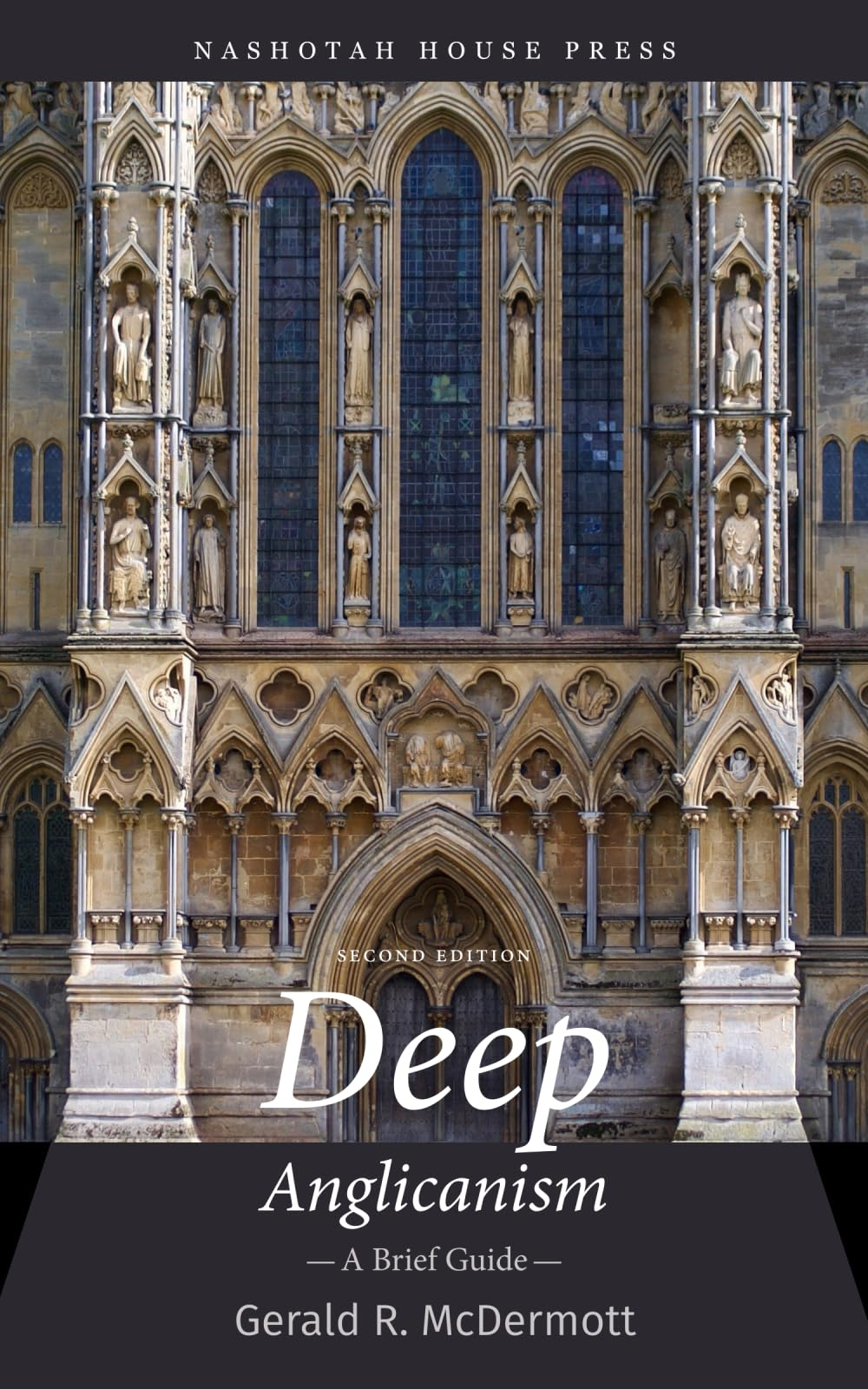I finished all of Deep Anglicanism by Gerald McDermott today, at just under 400 pages. Every word. The book offers a thorough and thoughtful overview of the Anglican tradition. It highlights both the common ground Anglicanism shares with Protestant, Catholic, and Orthodox churches and what sets it apart in its practice and theology. Anglicanism doesn’t claim to be the one true Church unlike Roman Catholicism or Eastern Orthodoxy. However, it strongly affirms the authority of Scripture and the importance of the sacraments, grounded in the teachings of the early Church Fathers. The author presents Anglicanism as both catholic and reformed, with its identity particularly rooted in the English Reformation. The book paints a compelling picture of what the Anglican Church can and should be, especially regarding its biblical foundation, liturgical worship, and sacramental life. While generally supportive of the Anglican Church in North America (ACNA), the author expresses serious concerns about its current direction, warning that it may be on a path similar to that of the Church of England and its demise in recent years.
The book Deep Anglicanism serves as a reference text, comprehensively exploring Anglican thought, faith, and practice. It is a necessary resource for the Church as a whole, addressing topics highly relevant to congregants, clergy, and the broader world. For readers seeking to understand Anglicanism’s background, history, and theological convictions—including its perspectives on doctrine, culture, social turmoil, and ecumenical positioning—this book provides basic biblically centered insights. McDermott’s thoughts rest firmly on the supreme authority of Scripture, interpreted according to the intent of its biblical authors, making it a critical guide for those who wish to engage with Anglicanism authentically and deeply.
Author Gerald McDermott highlights Anglicanism’s roots in the teachings of the patristic fathers, reformed and renewed during the 16th century. He explains how the Reformation corrected errors and abuses within the Roman Catholic Church, influencing churches in Canterbury, Constantinople, Rome, Geneva, and Wittenberg. Although Reformers, Puritans, and Anglicans were labeled “Protestant” as a pejorative, they aimed to recover biblical imperatives for faith and practice. According to McDermott, Anglicanism remains firm when correctly applying Scripture to doctrines like soteriology (sola fide), Christology, and ecclesiology while honoring its tradition.
The author organizes the book around essential segments that he believes are paramount to understanding Anglicanism. He covers topics like liturgy, the Book of Common Prayer (BCP), Anglican spirituality, the sacraments, marriage, death, and how the Anglican tradition compares to others like Lutheranism, Presbyterianism, Roman Catholicism, and Eastern Orthodoxy. The book isn’t trying to be an exhaustive history but rather offers a focused look at how Anglicanism can be understood as part of the broader catholic tradition. Throughout, McDermott encourages readers to think carefully and biblically about Anglican identity and how it is lived out.
As the chapters unfold, McDermott unpacks Anglican practices like prayer and worship, especially as shaped by the Book of Common Prayer. He shows how Anglicanism seeks to hold together Scripture, tradition, and ecclesiology in a way that’s faithful to the creeds and teachings of the English Reformers and the Anglo-Catholic tradition. He also takes on modern theological trends, challenging what he sees as distortions of the faith disguised as social justice. In particular, he critiques liberation theology and individualistic expressions of Christianity, tracing their roots to thinkers like Schleiermacher and arguing that they stray from biblical teaching.
While he doesn’t dwell extensively on harmful ideologies like feminism or egalitarianism, McDermott grounds his discussion in a vision of Anglicanism as a visible expression of God’s Kingdom on Earth. His attention to the Book of Common Prayer is especially prominent, and he explores how its development has shaped Anglican theology and practice.
According to McDermott, the BCP—especially Cranmer’s original version from 1549—was meant to unify the English Church around a common, vernacular liturgy rooted in Scripture. It replaced the Latin Sarum Rite with services people could understand and participate in. He explains how it preserved the sacramental structure of earlier worship but with a clearer focus on the authority of Scripture. The BCP blends prayer, Scripture reading, sacraments, and traditional forms of worship into a cohesive structure that reflects both Reformation priorities and ancient Christian practice.
Historically, the BCP became central to Anglican life and identity, anchoring worship practices in biblical theology while preserving the Church’s link to the catholic tradition. McDermott contrasts the God-centered orientation of the BCP with modern ideologies that, in his view, attempt to weaken biblical authority. He sees the BCP not just as a liturgical tool but as a theological and spiritual foundation for the Anglican way of life.
In specific chapters—such as 6, 10–12, 27, and 30—McDermott goes deeper into Anglicanism’s history, theology, and worship, paying particular attention to the Daily Office and the influence of major theologians. He presents Anglican spirituality as shaped by the Bible and the early Church, as well as the devotional movements of the medieval period and the theological insights of the Reformation. He discusses how Anglicanism navigates between sola scriptura and prima scriptura and how it approaches doctrines like hell.
On the Daily Office, McDermott explains its roots in early Christian monasticism, which itself drew on Jewish prayer traditions. The Benedictine Rule provided a framework for regular prayer, which was later adapted in England through the Sarum Rite. Cranmer’s reforms in the 16th century condensed these hours into Morning and Evening Prayer, making daily worship accessible to all Christians, not just monks. Morning Prayer combined Matins, Lauds, and Prime into a single service focused on thanksgiving, confession, and Scripture. Evening Prayer drew from Vespers and Compline, emphasizing reflection and gratitude. These services structured the day around Scripture and prayer, connecting modern believers to an ancient pattern of devotion.
The 2019 BCP, issued by the Anglican Church in North America, reflects a return to these older traditions while addressing the needs of the contemporary Church. Unlike the 1979 Episcopal version, which included various liturgical experiments, the 2019 edition restores Cranmer’s vision of clear, Scripture-based worship. Its layout—from the Daily Office to the Psalter and lectionary—aims to root Anglican spirituality in Scripture and tradition.
Cranmer’s initial 1549 Prayer Book was itself a careful reform. Drawing from early Christian theologians like Augustine and Basil and monastic traditions like Benedict’s, Cranmer sought to create a common worship life that emphasized order, grace, and Scripture. McDermott highlights how this reform retained sacramental depth while grounding services in the Bible.
He also draws attention to the influence of figures like Augustine, Benedict, and Anselm on Anglican spirituality. Augustine’s theology of grace, Benedict’s focus on disciplined prayer, and Anselm’s blending of devotion and reason all helped shape Anglicanism’s spiritual landscape. These influences were later developed by thinkers like Martin Thornton, who saw Anglican spirituality as a balance of corporate worship, structured devotion, and thoughtful theology.
Medieval English mystics such as Richard Rolle, Walter Hilton, and Julian of Norwich also left their mark on Anglican devotion. In the post-Reformation period, divines like Lancelot Andrewes, Richard Hooker, and Jeremy Taylor continued this tradition, each emphasizing different aspects of sacramental theology, liturgy, and spiritual formation. Hooker, in particular, helped define the Anglican “middle way”—a theology that holds together Protestant and Catholic elements.
McDermott discusses how Anglicanism relates to the principle of sola scriptura. While holding Scripture as the final authority, he argues that Anglicanism traditionally affirms prima scriptura, meaning Scripture is best interpreted within the context of Church tradition and reason. This approach allows Anglican theology to be biblically faithful while engaging the wisdom of the historic Church.
He also explores changing views on the doctrine of hell within Anglicanism. He traces the idea of universal salvation back to Origen, noting its resurgence in modern theology. He outlines three dominant views: eternal conscious torment, annihilationism, and universalism. While the Thirty-Nine Articles affirm the reality of hell, contemporary Anglican thinkers debate its nature and duration. McDermott presents these positions clearly, offering both traditional and alternative interpretations within the bounds of Anglican theological discourse.
On the sacraments, he highlights that they are a visible image or a reflection of the sacred that is itself invisible. A sacred signum, for example, is baptism as a cleansing from sin. The bread and wine represent the sacred signum as the actuality of the body and blood of Christ. As such, these are visible signs of an invisible grace. These are the means by which salvation is made possible to humanity and made real to believers in Christ. The sacraments are the work of Christ himself, and they are independent of the worthiness of the minister serving them. Moreover, according to Aquinas, they are made present to us as it is necessary to know them through our senses (Summa Theologica III.60.I). As the hearts of people are darkened by sin (Romans 1:21), Christ makes holy His people through His grace via the sacraments while He is bodily absent. The sacraments, in this way, are a means of grace.
With more specifics, McDermott informs readers that sacraments inform us about what they do as a means of Christ’s grace. That they are re-enactments of Christ’s passion applied to us as believers. They are lived out within each person as they have a direct bearing and action upon those who live, suffer, and die as Christ did. They apply to us as if we had suffered and died. Similarly, Aquinas wrote that the sacraments cause divine realities to happen where Christ is brought as gifts to the present as his love is communicated to His family. The sacraments are sacred actions that change participants’ lives. They possess a hidden power as they show invisible evidence where they appear in additional things like the Lord’s Prayer and the creeds.
The book Deep Anglicanism covers many topics pertaining to the Anglican tradition and expression of faith. Taken together, McDermott’s work presents a picture of Anglicanism as a tradition grounded in Scripture, shaped by history, and capable of addressing modern challenges without losing its core identity. His writing encourages a deeper appreciation for Anglican worship and spirituality as a living inheritance that continues to speak to today’s Church.















